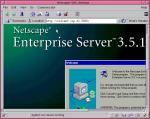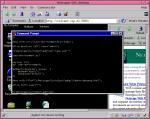Some time ago an acquantaince of mine (Christian Vandendorpe,
see www.zorglub.com) had drawn my
attention to a joint Oracle and Olivetti
research effort. One of their products is Virtual Network Computing
(VNC). VNC is a technology that allows the remote takeover of a console
(screen, keyboard and mouse) from a wide range of client workstation types.
The VNC server runs a background service that accepts connection requests
from VNC clients. Once the connection is authenticated and authorised (for
now through a simple password scheme) the VNC server sends updates to the
screen to the VNC client and accepts keyboard and mouse input from the
VNC client. In this respect, VNC is a lot like popular packages
such as "PC Anywhere" and "ReachOut Remote".
An interesting aspect about VNC is the wide range of clients and servers
they have available. There are servers for Windows/NT and UNIX (X-Windows),
and clients for UNIX, Win32, Macintosh and even Java! The VNC Java
viewer allows you to make a connection to a VNC server from any Java
compatible browser!
I had played with VNC once before. One of my co-workers at a large project
had downloaded VNC for UNIX and compiled it on HP-UX 11.0. Using this and
the VNC viewer for Win32 we were able to run X-Windows programs on
our Windows NT workstation dekstops without acquiring a license for
a commercial Win32 X-Server from our local IT department. This saved us
bureaucracy, money and significant headaches. VNC for UNIX is
a bit difficult to compile, but with some stamina can be done by even the
moderately gifted (like me :-).
In the situation at hand I would require the VNC server for Windows
NT and a viewer for Linux. The NT VNC server can be downloaded as binary
executables, and installation of the package is a breeze. I remembered
from Christian's demonstrations that every VNC server includes the Java
viewer, and that the VNC server even contains a small HTTP server
that can be used to download and run the Java viewer from a browser! For
now, I would go for the Java viewer running in my Netscape Communicator
4.5 browser
 After
installing the VNC server (with the compulsary reboot of course) I started
it and then fired up my browser. I did not immediately know which port
of the Reliant to connect to, but after only a short perusal of the ORL
web site I reckoned that the VNC web server should be at port 5800. I pointed
my browser at "http://reliant.osp.nl:5800" and there it was! Although the
Java viewer is not exceptionally fast (it is actually quite slow), it would
suffice for the relatively minor use I would make of it. Through the viewer
I was able to install the Netscape server software and stop/start it through
the NT Services control panel. The viewer worked so well that I did
not even bother to "smbmount" the NT file systems in order to get to the
Netscape server configuration files: I just fired up a command prompt window
on NT and used the Win32 version of "vim"
to edit them.
After
installing the VNC server (with the compulsary reboot of course) I started
it and then fired up my browser. I did not immediately know which port
of the Reliant to connect to, but after only a short perusal of the ORL
web site I reckoned that the VNC web server should be at port 5800. I pointed
my browser at "http://reliant.osp.nl:5800" and there it was! Although the
Java viewer is not exceptionally fast (it is actually quite slow), it would
suffice for the relatively minor use I would make of it. Through the viewer
I was able to install the Netscape server software and stop/start it through
the NT Services control panel. The viewer worked so well that I did
not even bother to "smbmount" the NT file systems in order to get to the
Netscape server configuration files: I just fired up a command prompt window
on NT and used the Win32 version of "vim"
to edit them. One
of the problems I still had was that the VNC server had to be restarted
manually after every NT system reboot. Presumably this can be automated
either through VNC's own capabilities of through the OSP utility "RC.EXE"
(which allows some sort of "autoexec.bat" for Windows/NT systems). Something
I might want to look into later,......
One
of the problems I still had was that the VNC server had to be restarted
manually after every NT system reboot. Presumably this can be automated
either through VNC's own capabilities of through the OSP utility "RC.EXE"
(which allows some sort of "autoexec.bat" for Windows/NT systems). Something
I might want to look into later,......